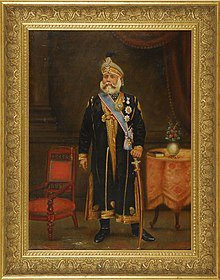Raja Dahir (Sindhi pronunciation: [rɑːɟɑː ɗɑːɦirə]; Sindhi: رَاجَا ڏَاهِرَ ,राजा ॾाहिर; Sanskrit: राजा दाहिर सेन, IAST: Raja Dahir; 663 – 712 CE) was the last Hindu ruler of Sindh in the western region of the Indian subcontinent that is now located in modern Pakistan after partition of India in 1947.[1] In 711 CE his kingdom was invaded by the Ummayad Caliphate led by Muhammad bin Qasim where Dahir died while defending his kingdom. According to the Chachnama, the Umayyad campaign against Arori Raja Dahir was due to a pirate raid off the coast of the Sindhi coast that resulted in gifts to the Ummayad caliph from the king of Serendib being stolen.[2][3]
He was killed at the Battle of Aror which took place between his dynasty and the Arabs at the banks of the Indus River, near modern-day Nawabshah at the hands of the Arab general Muhammad bin Qasim. His body was then decapitated and his head was sent to the governor of Basra, Al-Hajjaj ibn Yusuf. His headless body was then cremated by his own soldiers[citation needed]. His family name is now carried as Dahri clan which is known to be now living in Nawabshah District & Sanghar.
Reign in the Chach Nama
The Chach Nama is the oldest chronicles of the Arab conquest of Sindh. It was translated in Persian by an Arab named Muhammad Ali bin Hamid bin Abu Bakr Kufi in 1216 CE[4] from an earlier Arabic text believed to have been written by the Thaqafi family (relatives of Mukhtar al-Thaqafi).
Raja Dahir’s kingdom was also raided several times by the Buddhist kingdom of Kannauj.[5]
War with the Umayyads
“I am going to meet the Arabs in open battle, and fight them as best as I can. If I crush them, my kingdom will then be put on a firm footing. But if I am killed honourably, the event will be recorded in the books of Arabia and India and will be talked about by great men. It will be heard by other kings in the world, and it will be said that Raja Dahir of Sindh sacrificed his precious life for the sake of his country, in fighting with the enemy.”[6]
The primary reason cited in the Chach Nama for the expedition by the governor of Basra, Al-Hajjaj ibn Yusuf, against Raja Dahir, was a pirate raid off the coast of Debal resulting in gifts to the caliph from the king of Serendib (modern Sri Lanka) being stolen.[7] Meds (a tribe of Scythians living in Sindh) also known as Bawarij had pirated upon Sassanid shipping in the past, from the mouth of the Tigris to the Sri Lankan coast, and now they were able to prey on Arab shipping from their bases at Kutch, Debal and Kathiawar.
Hajaj’s next campaign was launched under the aegis of Muhammad bin Qasim. In 711 CE, bin Qasim attacked at Debal and, on orders of Al-Hajjaj, freed the earlier captives and prisoners from the previous (failed) campaign. Other than this instance, the policy was generally one of enlisting and co-opting support from defectors and defeated lords and forces. From Debal, bin Qasim moved on to Nerun for supplies; the city’s Buddhist governor had acknowledged it as a tributary of the Caliphate after the first campaign and capitulated to the second. Qasim’s armies then captured Siwistan and received allegiance from several tribal chiefs and secured the surrounding regions. His combined forces captured the fort at Sisam and secured the region west of the Indus River.
By enlisting the support of local tribes such as the Meds and also the support of the Buddhist rulers of Nerun, Bajhra, Kaka Kolak and Siwistan as infantry to his predominantly-mounted army, Muhammad bin Qasim defeated Dahir and captured his eastern territories which were added into the Umayyad Caliphate.[8]
Sometime before the final battle, Dahir’s vizier approached him and suggested that Dahir should take refuge with one of the friendly kings of India. “You should say to them, ‘I am a wall between you and the Arab army. If I fall, nothing will stop your destruction at their hands.'” If that wasn’t acceptable to Dahir, said the vizier, then he should at least send away his family to some safe point in India. Dahir refused to do either. “I cannot send away my family to security while the families of my thakurs and nobles remain here.”[8]
Dahir then tried to prevent Qasim from crossing the Indus River, moving his forces to its eastern banks. Eventually, however, Qasim crossed the river and defeated his forces at Jitor led by Jaisiah (Dahir’s son). Qasim fought Dahir at Raor (near modern Nawabshah) in 711, eventually killing him. After Dahir was killed in the Battle of Aror on the banks of the River Indus, his head was cut off from his body and sent to Hajjaj bin Yousuf.

